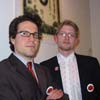Three years ago, Jason Asselin and Marybeth Mungovan, both 2001 graduates, responded to an open call by the Massachusetts Bay Transportation Authority (MBTA) for a site-specific work to enhance the in-progress Boston World Trade Center station on the new Silver Line. Fresh out of college and filled with ideas, they were up against more than 250 artists, some older and a lot more established.
Despite the heavy competition, they won the grant with their proposal of a four-foot by 90-foot mural made of 18 lenticulars - large curved lenses made of corrugated plastic - each containing stacked still frames of swimming goldfish. The mural resembles a gigantic motion-image card, similar to what one might find on a Crackerjacks box. As one's point of view changes while walking by, the image changes, creating the illusion of swimming fish. "It's almost like your body activates the piece," said Asselin.
"Some of the applicants were nationally-acclaimed artists," said Barbara Boylan, an architect and director of design at the MBTA, who was the MBTA representative for the publicly solicited panel of jurors which chose the winning idea. The panel, which included an artist, an academic, a curator, and a community member, did not learn who the applicants were until the last round, in which they interviewed their top five choices.
"The lenticular mural was a 'first' for the MBTA, not only in the selection of a new medium - a hologram and lenticular mural - and something never tried before, but also in the very fact that this was the 'first' commission for these artists," said Boylan. "It is a fantastic piece of marine theme relative to the seaport that will give every commuter the chance to see something 'new' in the transforming hologram everyday on their way to work or recreation at the South Boston waterfront."
Asselin and Mungovan heard about the call for artists from a friend. "What impressed me the most is the fact that they went for it without any outside help," said Meredith Morten, chair of the Sculpture Department at Montserrat. "They didn't swing it by us until they made the last round."
Asselin and Mungovan came up with the idea through a little digging. "I went down there and actually met up with the architect," said Mungovan. She found out that the architect was planning a sort of marine-themed interior, with curvy wave-shaped neon lights to go with the undulating ceiling. The perfect environment for an aquatic mural.
The idea of the Silver Line, which consists of Bus Rapid Transit (BRT) lines, is efficiency and technology - in tunnels the buses run on electricity and aboveground on an energy-efficient fuel. "There's this whole notion of being environmentally friendly and highly scientific," said Asselin, and a lenticular is the perfect marriage of technology and art.
The idea came easier than actually putting the project into motion - literally. "We bought about 50 goldfish, put them all in a tank, and did hours and hours of videotaping and even more hours of editing," said Mungovan. First they put a blue sheet behind the tank to make the background crisp and bright, contrasting with the bright orange goldfish. Then they grappled with the lighting. "We would put the fish tank into the sunlight when we were videotaping and fish don't really like the sunlight all that much," said Asselin. Plus, the dust particles, illuminated from the sun, would get in the way. "So we'd have to wait for the stuff to settle. And then they'd make air bubbles. So you've got to kind of get everything just right."
Then they had to deal with getting the fish, who tended to hang out at the bottom of the tank, to cooperate. "We'd have to make them do tricks," said Mungovan, like putting food in the tank to make them swim around. But then the tank would get dirty from the food. "And we'd have to clean the tank and start all over again."
In the end, what they did, essentially, is cut down the hours of tape into a 12-second, carefully choreographed digital video. A special lenticular printer in New York exported each still frame, stacking groups of 20 frames to create the movement for each of the 18 lenticulars. In all, there are 360 frames in the mural.
The artists named the piece, You Are Here, referencing time passage as well as motion. "As you're walking by, the mural unravels itself. We wanted people to be focused on thinking at that moment, what's going on in the present time," said Mungovan. There's also the connection to maps, such as the "You Are Here" point on a map. "So we decided that when you get to the middle of the lenticular, the words come up that say, 'You Are Here,'" said Asselin.
Their creativity has been evident for a while. "As undergraduates they always had perceptive ideas and expressed articulate and critical discourse," said Morten. "They're thinkers."
The section of the Silver Line containing the World Trade Center stop - which stretches from South Station to the South Boston Waterfront - began service in December. This section will eventually be connected to the southern portion of the line, which runs from Dudley Station to Downtown Crossing, according to the MBTA's website.
The two artists are both from the Worcester area. Currently Asselin is finishing graduate work - after a two-year hiatus for this project - to study printmaking at Cranbrook Academy of Art. Mungovan is staying in the New England area, applying to graduate school, and looking for more projects.
- Marine-inspired fluid lines at the new station
- The entrance to the new World Trade Center Silver Line station
- A detail of the new lenticular mural.
Links:
Montserrat College of Art
All images are courtesy of the artists, the MBTA adn Montserrat.
This news item was provided by Betsy O'Neill, Director of Public Relations, Montserrat College of Art







